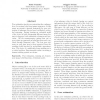Free Online Productivity Tools
i2Speak
i2Symbol
i2OCR
iTex2Img
iWeb2Print
iWeb2Shot
i2Type
iPdf2Split
iPdf2Merge
i2Bopomofo
i2Arabic
i2Style
i2Image
i2PDF
iLatex2Rtf
Sci2ools
ISIPTA
2005
IEEE
2005
IEEE
Evidential modeling for pose estimation
Pose estimation involves reconstructing the configuration of a moving body from images sequences. In this paper we present a general framework for pose estimation of unknown objects based on Shafer’s evidential reasoning. During learning an evidential model of the object is built, integrating different image features to improve both estimation robustness and precision. All the measurements coming from one or more views are expressed as belief functions, and combined through Dempster’s rule. The best pose estimate at each time step is then extracted from the resulting belief function by probabilistic approximation. The choice of a sufficiently dense training set is a critical problem. Experimental results concerning a human tracking system are shown. Keywords. Pose estimation, training set, featurepose maps, belief functions, evidential model.
| Added | 25 Jun 2010 |
| Updated | 25 Jun 2010 |
| Type | Conference |
| Year | 2005 |
| Where | ISIPTA |
| Authors | Fabio Cuzzolin, Ruggero Frezza |
Comments (0)

